Enhancement Methods of Antioxidant Capacity in Rice Bran: A Review
Abstract
1. Introduction
2. Comparison of Japonica and Indica
3. Isolation Methods and Bioactive Compound Content in Rice Bran from Three Types of Grain Colors
3.1. White Rice Bran
3.2. Red Rice Bran
3.3. Black Rice Bran
4. Extraction/Isolation Methods Using Non-Toxic Solvent
5. Rice Bran Bioactivity and Test Methods
5.1. Antimicrobial
5.2. Antioxidant
5.3. Cancer Chemopreventive
5.4. Antidiabetic
5.5. Hypolipidemic Agents
6. Phenolic Compound in Rice Bran as Antioxidant Properties
7. Enhancement of The Antioxidant Capacity Method in Rice Bran
8. Conclusions
9. Patents
Author Contributions
Funding
Institutional Review Board Statement
Informed Consent Statement
Data Availability Statement
Acknowledgments
Conflicts of Interest
References
- Arfin, S.; Jha, N.K.; Jha, S.K.; Kesari, K.K.; Ruokolainen, J.; Roychoudhury, S.; Rathi, B.; Kumar, D. Oxidative Stress in Cancer Cell Metabolism. Antioxidants 2021, 10, 642. [Google Scholar] [CrossRef] [PubMed]
- Ighodaro, O.M. Molecular Pathways Associated with Oxidative Stress in Diabetes Mellitus. Biomed. Pharmacother. 2018, 108, 656–662. [Google Scholar] [CrossRef] [PubMed]
- Chehaibi, K.; Trabelsi, I.; Mahdouani, K.; Slimane, M.N. Correlation of Oxidative Stress Parameters and Inflammatory Markers in Ischemic Stroke Patients. J. Stroke Cerebrovasc. Dis. 2016, 25, 2585–2593. [Google Scholar] [CrossRef]
- Shaik, F.B.; Nagajothi, G.; Swarnalatha, K.; Kumar, C.S.; Rajendra, W.; Maddu, N. Correlation between Smokeless Tobacco (Gutkha) and Biomarkers of Oxidative Stress in Plasma with Cardiovascular Effects. Heliyon 2021, 7, e05487. [Google Scholar] [CrossRef] [PubMed]
- Francenia Santos-Sánchez, N.; Salas-Coronado, R.; Villanueva-Cañongo, C.; Hernández-Carlos, B. Antioxidant Compounds and Their Antioxidant Mechanism. In Antioxidants; Shalaby, E., Ed.; IntechOpen: London, UK, 2019; ISBN 978-1-78923-919-5. [Google Scholar]
- Lü, J.-M.; Lin, P.H.; Yao, Q.; Chen, C. Chemical and Molecular Mechanisms of Antioxidants: Experimental Approaches and Model Systems. J. Cell. Mol. Med. 2010, 14, 840–860. [Google Scholar] [CrossRef] [PubMed]
- Bordiga, M.; Gomez-Alonso, S.; Locatelli, M.; Travaglia, F.; Coïsson, J.D.; Hermosin-Gutierrez, I.; Arlorio, M. Phenolics Characterization and Antioxidant Activity of Six Different Pigmented Oryza Sativa L. Cultivars Grown in Piedmont (Italy). Food Res. Int. 2014, 65, 282–290. [Google Scholar] [CrossRef]
- Dutta, A.K.; Gope, P.S.; Banik, S.; Makhnoon, S.; Siddiquee, M.A.; Kabir, Y. Antioxidant Properties of Ten High Yielding Rice Varieties of Bangladesh. Asian Pac. J. Trop. Biomed. 2012, 2, S99–S103. [Google Scholar] [CrossRef]
- Apea-Bah, F.B.; Li, X.; Beta, T. Phenolic Composition and Antioxidant Properties of Cooked Rice Dyed with Sorghum-Leaf Bio-Colorants. Foods 2021, 10, 2058. [Google Scholar] [CrossRef]
- Du, S.; Huang, X.; Cai, Y.; Hao, Y.; Qiu, S.; Liu, L.; Cui, M.; Luo, L. Differential Antioxidant Compounds and Activities in Seedlings of Two Rice Cultivars Under Chilling Treatment. Front. Plant Sci. 2021, 12, 631421. [Google Scholar] [CrossRef]
- Hao, J.; Zhu, H.; Zhang, Z.; Yang, S.; Li, H. Identification of Anthocyanins in Black Rice (Oryza Sativa L.) by UPLC/Q-TOF-MS and Their in Vitro and in Vivo Antioxidant Activities. J. Cereal Sci. 2015, 64, 92–99. [Google Scholar] [CrossRef]
- Palungwachira, P.; Tancharoen, S.; Phruksaniyom, C.; Klungsaeng, S.; Srichan, R.; Kikuchi, K.; Nararatwanchai, T. Antioxidant and Anti-Inflammatory Properties of Anthocyanins Extracted from Oryza Sativa L. in Primary Dermal Fibroblasts. Oxidative Med. Cell. Longev. 2019, 2019, 2089817. [Google Scholar] [CrossRef] [PubMed]
- Moongngarm, A.; Daomukda, N.; Khumpika, S. Chemical Compositions, Phytochemicals, and Antioxidant Capacity of Rice Bran, Rice Bran Layer, and Rice Germ. APCBEE Procedia 2012, 2, 73–79. [Google Scholar] [CrossRef]
- Aguilar-Garcia, C.; Gavino, G.; Baragaño-Mosqueda, M.; Hevia, P.; Gavino, V.C. Correlation of Tocopherol, Tocotrienol, γ-Oryzanol and Total Polyphenol Content in Rice Bran with Different Antioxidant Capacity Assays. Food Chem. 2007, 102, 1228–1232. [Google Scholar] [CrossRef]
- Martillanes, S.; Ayuso-Yuste, M.C.; Gil, M.V.; Manzano-Durán, R.; Delgado-Adámez, J. Bioavailability, Composition and Functional Characterization of Extracts from Oryza Sativa L. Bran. Food Res. Int. 2018, 111, 299–305. [Google Scholar] [CrossRef]
- Ghasemzadeh, A.; Karbalaii, M.T.; Jaafar, H.Z.E.; Rahmat, A. Phytochemical Constituents, Antioxidant Activity, and Antiproliferative Properties of Black, Red, and Brown Rice Bran. Chem. Cent. J. 2018, 12, 17. [Google Scholar] [CrossRef]
- Yang, Y.; Zhu, K.; Xia, H.; Chen, L.; Chen, K. Comparative Proteomic Analysis of Indica and Japonica Rice Varieties. Genet. Mol. Biol. 2014, 37, 652–661. [Google Scholar] [CrossRef]
- Pang, Y.; Ahmed, S.; Xu, Y.; Beta, T.; Zhu, Z.; Shao, Y.; Bao, J. Bound Phenolic Compounds and Antioxidant Properties of Whole Grain and Bran of White, Red and Black Rice. Food Chem. 2018, 240, 212–221. [Google Scholar] [CrossRef]
- Oppong, D.; Panpipat, W.; Chaijan, M. Chemical, Physical, and Functional Properties of Thai Indigenous Brown Rice Flours. PLoS ONE 2021, 16, e0255694. [Google Scholar] [CrossRef]
- Fongfon, S.; Pusadee, T.; Prom-u-thai, C.; Rerkasem, B.; Jamjod, S. Diversity of Purple Rice (Oryza Sativa L.) Landraces in Northern Thailand. Agronomy 2021, 11, 2029. [Google Scholar] [CrossRef]
- Shao, Y.; Xu, F.; Sun, X.; Bao, J.; Beta, T. Identification and Quantification of Phenolic Acids and Anthocyanins as Antioxidants in Bran, Embryo and Endosperm of White, Red and Black Rice Kernels (Oryza Sativa L.). J. Cereal Sci. 2014, 59, 211–218. [Google Scholar] [CrossRef]
- Martillanes, S.; Rocha-Pimienta, J.; Gil, M.V.; Ayuso-Yuste, M.C.; Delgado-Adámez, J. Antioxidant and Antimicrobial Evaluation of Rice Bran (Oryza Sativa L.) Extracts in a Mayonnaise-Type Emulsion. Food Chem. 2020, 308, 125633. [Google Scholar] [CrossRef] [PubMed]
- Verschoyle, R.D.; Greaves, P.; Cai, H.; Edwards, R.E.; Steward, W.P.; Gescher, A.J. Evaluation of the Cancer Chemopreventive Efficacy of Rice Bran in Genetic Mouse Models of Breast, Prostate and Intestinal Carcinogenesis. Br. J. Cancer 2007, 96, 248–254. [Google Scholar] [CrossRef] [PubMed]
- Boue, S.M.; Daigle, K.W.; Chen, M.-H.; Cao, H.; Heiman, M.L. Antidiabetic Potential of Purple and Red Rice (Oryza Sativa L.) Bran Extracts. J. Agric. Food Chem. 2016, 64, 5345–5353. [Google Scholar] [CrossRef] [PubMed]
- Chandrashekar, P.; Kumar, P.K.P.; Ramesh, H.P.; Lokesh, B.R.; Krishna, A.G.G. Hypolipidemic Effect of Oryzanol Concentrate and Low Temperature Extracted Crude Rice Bran Oil in Experimental Male Wistar Rats. J. Food Sci. Technol. 2014, 51, 1278–1285. [Google Scholar] [CrossRef]
- Wang, W.; Guo, J.; Zhang, J.; Peng, J.; Liu, T.; Xin, Z. Isolation, Identification and Antioxidant Activity of Bound Phenolic Compounds Present in Rice Bran. Food Chem. 2015, 171, 40–49. [Google Scholar] [CrossRef]
- Shin, H.-Y.; Kim, S.-M.; Lee, J.H.; Lim, S.-T. Solid-State Fermentation of Black Rice Bran with Aspergillus Awamori and Aspergillus Oryzae: Effects on Phenolic Acid Composition and Antioxidant Activity of Bran Extracts. Food Chem. 2019, 272, 235–241. [Google Scholar] [CrossRef]
- Chen, Y.; Ma, Y.; Dong, L.; Jia, X.; Liu, L.; Huang, F.; Chi, J.; Xiao, J.; Zhang, M.; Zhang, R. Extrusion and Fungal Fermentation Change the Profile and Antioxidant Activity of Free and Bound Phenolics in Rice Bran Together with the Phenolic Bioaccessibility. LWT 2019, 115, 108461. [Google Scholar] [CrossRef]
- Jan-on, G.; Sangartit, W.; Pakdeechote, P.; Kukongviriyapan, V.; Sattayasai, J.; Senaphan, K.; Kukongviriyapan, U. Virgin Rice Bran Oil Alleviates Hypertension through the Upregulation of ENOS and Reduction of Oxidative Stress and Inflammation in L-NAME–Induced Hypertensive Rats. Nutrition 2020, 69, 110575. [Google Scholar] [CrossRef]
- Pacheco de Delahaye, E.; Jiménez, P.; Pérez, E. Effect of Enrichment with High Content Dietary Fiber Stabilized Rice Bran Flour on Chemical and Functional Properties of Storage Frozen Pizzas. J. Food Eng. 2005, 68, 1–7. [Google Scholar] [CrossRef]
- Irakli, M.; Mygdalia, A.; Chatzopoulou, P.; Katsantonis, D. Impact of the Combination of Sourdough Fermentation and Hop Extract Addition on Baking Properties, Antioxidant Capacity and Phenolics Bioaccessibility of Rice Bran-Enhanced Bread. Food Chem. 2019, 285, 231–239. [Google Scholar] [CrossRef]
- Chaves, J.O.; de Souza, M.C.; da Silva, L.C.; Lachos-Perez, D.; Torres-Mayanga, P.C.; Machado, A.P.d.F.; Forster-Carneiro, T.; Vázquez-Espinosa, M.; González-de-Peredo, A.V.; Barbero, G.F.; et al. Extraction of Flavonoids From Natural Sources Using Modern Techniques. Front. Chem. 2020, 8, 507887. [Google Scholar] [CrossRef] [PubMed]
- Zhang, Q.-W.; Lin, L.-G.; Ye, W.-C. Techniques for Extraction and Isolation of Natural Products: A Comprehensive Review. Chinese Med. 2018, 13, 1–26. [Google Scholar] [CrossRef] [PubMed]
- Aziz, S.; Elfahmi, Y.; Soemardji, A.A.; Sukrasno, S. Anti-Hypercholesterolemic Agent from Indonesian Rice Bran. Int. J. Res. Pharm. Sci. 2019, 10, 2733–2738. [Google Scholar] [CrossRef]
- Moko, E.M.; Rahardiyan, D. Structure of Stigmasterols in Bran of Red Rice from Minahasa Regency, North Sulawesi, Indonesia. Fuller. J. Chem. 2020, 5, 16. [Google Scholar] [CrossRef]
- Rungratanawanich, W.; Memo, M.; Uberti, D. Redox Homeostasis and Natural Dietary Compounds: Focusing on Antioxidants of Rice (Oryza Sativa L.). Nutrients 2018, 10, 1605. [Google Scholar] [CrossRef]
- Koizumi, T.; Furuhashi, G. Global Rice Market Projections Distinguishing Japonica and Indica Rice under Climate Change. JARQ 2020, 54, 63–91. [Google Scholar] [CrossRef]
- Morales-Martínez, L.E.; Bello-Pérez, L.A.; Sánchez-Rivera, M.M.; Ventura-Zapata, E.; Jiménez-Aparicio, A.R. Morphometric, Physicochemical, Thermal, and Rheological Properties of Rice (Oryza Sativa L.) Cultivars Indica & Japonica. Food Nutr. Sci. 2014, 05, 271–279. [Google Scholar] [CrossRef][Green Version]
- Ding, C.; Liu, Q.; Li, P.; Pei, Y.; Tao, T.; Wang, Y.; Yan, W.; Yang, G.; Shao, X. Distribution and Quantitative Analysis of Phenolic Compounds in Fractions of Japonica and Indica Rice. Food Chem. 2019, 274, 384–391. [Google Scholar] [CrossRef]
- Peanparkdee, M.; Patrawart, J.; Iwamoto, S. Effect of Extraction Conditions on Phenolic Content, Anthocyanin Content and Antioxidant Activity of Bran Extracts from Thai Rice Cultivars. J. Cereal Sci. 2019, 86, 86–91. [Google Scholar] [CrossRef]
- Pokkanta, P.; Sookwong, P.; Tanang, M.; Setchaiyan, S.; Boontakham, P.; Mahatheeranont, S. Simultaneous Determination of Tocols, γ-Oryzanols, Phytosterols, Squalene, Cholecalciferol and Phylloquinone in Rice Bran and Vegetable Oil Samples. Food Chem. 2019, 271, 630–638. [Google Scholar] [CrossRef]
- Hansakul, P.; Srisawat, U.; Kaendee, N.; Panunto, W. Determination of Phenolic Compounds, Flavonoids, and Antioxidant Activities in Crude Water Extracts of Thai Red and White Rice Cultivars. Planta Med. 2010, 76, s-0030-1264431. [Google Scholar] [CrossRef] [PubMed]
- Jun, H.-I.; Song, G.-S.; Yang, E.-I.; Youn, Y.; Kim, Y.-S. Antioxidant Activities and Phenolic Compounds of Pigmented Rice Bran Extracts. J. Food Sci. 2012, 77, C759–C764. [Google Scholar] [CrossRef] [PubMed]
- Huang, Y.-P.; Lai, H.-M. Bioactive Compounds and Antioxidative Activity of Colored Rice Bran. J. Food Drug Anal. 2016, 24, 564–574. [Google Scholar] [CrossRef]
- Pengkumsri, N.; Chaiyasut, C.; Saenjum, C.; Sirilun, S.; Peerajan, S.; Suwannalert, P.; Sirisattha, S.; Sivamaruthi, B.S. Physicochemical and Antioxidative Properties of Black, Brown and Red Rice Varieties of Northern Thailand. Food Sci. Technol. 2015, 35, 331–338. [Google Scholar] [CrossRef]
- Ghasemzadeh, A.; Baghdadi, A.; Jaafar, Z.E.H.; Swamy, M.; Megat Wahab, P. Optimization of Flavonoid Extraction from Red and Brown Rice Bran and Evaluation of the Antioxidant Properties. Molecules 2018, 23, 1863. [Google Scholar] [CrossRef] [PubMed]
- Pengkumsri, N.; Chaiyasut, C.; Sivamaruthi, B.S.; Saenjum, C.; Sirilun, S.; Peerajan, S.; Suwannalert, P.; Sirisattha, S.; Chaiyasut, K.; Kesika, P. The Influence of Extraction Methods on Composition and Antioxidant Properties of Rice Bran Oil. Food Sci. Technol. 2015, 35, 493–501. [Google Scholar] [CrossRef]
- Sapna, I.; Jayadeep, A. Role of Endoxylanase and Its Concentrations in Enhancing the Nutraceutical Components and Bioactivities of Red Rice Bran. LWT 2021, 147, 111675. [Google Scholar] [CrossRef]
- Das, A.B.; Goud, V.V.; Das, C. Extraction of Phenolic Compounds and Anthocyanin from Black and Purple Rice Bran (Oryza Sativa L.) Using Ultrasound: A Comparative Analysis and Phytochemical Profiling. Ind. Crops Prod. 2017, 95, 332–341. [Google Scholar] [CrossRef]
- Phetpornpaisan, P.; Tippayawat, P.; Jay, M.; Sutthanut, K. A Local Thai Cultivar Glutinous Black Rice Bran: A Source of Functional Compounds in Immunomodulation, Cell Viability and Collagen Synthesis, and Matrix Metalloproteinase-2 and -9 Inhibition. J. Funct. Foods 2014, 7, 650–661. [Google Scholar] [CrossRef]
- Moirangthem, K.; Ramakrishna, P.; Amer, M.H.; Tucker, G.A. Bioactivity and Anthocyanin Content of Microwave-Assisted Subcritical Water Extracts of Manipur Black Rice (Chakhao) Bran and Straw. Future Foods 2021, 3, 100030. [Google Scholar] [CrossRef]
- Li, B.; Du, W.; Qian, D.; Du, Q. Combination of High-Speed Countercurrent Chromatography and Reversed Phase C18 Chromatography for Large-Scale Isolation of Cyanidin-3-O-β-d-Glucoside from Black Rice Bran Extract. Ind. Crops Prod. 2012, 37, 88–92. [Google Scholar] [CrossRef]
- Hou, F.; Zhang, R.; Zhang, M.; Su, D.; Wei, Z.; Deng, Y.; Zhang, Y.; Chi, J.; Tang, X. Hepatoprotective and Antioxidant Activity of Anthocyanins in Black Rice Bran on Carbon Tetrachloride-Induced Liver Injury in Mice. J. Funct. Foods 2013, 5, 1705–1713. [Google Scholar] [CrossRef]
- Zhang, M.W.; Zhang, R.F.; Zhang, F.X.; Liu, R.H. Phenolic Profiles and Antioxidant Activity of Black Rice Bran of Different Commercially Available Varieties. J. Agric. Food Chem. 2010, 58, 7580–7587. [Google Scholar] [CrossRef] [PubMed]
- Sriseadka, T.; Wongpornchai, S.; Rayanakorn, M. Quantification of Flavonoids in Black Rice by Liquid Chromatography-Negative Electrospray Ionization Tandem Mass Spectrometry. J. Agric. Food Chem. 2012, 60, 11723–11732. [Google Scholar] [CrossRef]
- Pratiwi, R.; Tunjung, W.A.S.; Rumiyati, R.; Amalia, A.R. Black Rice Bran Extracts and Fractions Containing Cyanidin 3-Glucoside and Peonidin 3-Glucoside Induce Apoptosis in Human Cervical Cancer Cells. Indones. J. Biotechnol. 2016, 20, 69. [Google Scholar] [CrossRef]
- Vardhani, A.; Jufri, M.; Purwaningsih, E. Potency of γ-Oryzanol Rich Black Rice Bran (Oryza Sativa L. Indica) Extract for Tyrosinase Inhibition. Int. J. Pharm. Pharm. Sci. 2020, 12, 90–93. [Google Scholar] [CrossRef]
- Chumpolsri, W.; Wijit, N.; Boontakham, P.; Nimmanpipug, P.; Sookwong, P.; Luangkamin, S.; Wongpornchai, S. Variation of Terpenoid Flavor Odorants in Bran of Some Black and White Rice Varieties Analyzed by GC×GC-MS. J. Food Nutr. Res. 2015, 3, 114–120. [Google Scholar] [CrossRef]
- Taniguchi, M.; Kameda, M.; Namae, T.; Ochiai, A.; Saitoh, E.; Tanaka, T. Identification and Characterization of Multifunctional Cationic Peptides Derived from Peptic Hydrolysates of Rice Bran Protein. J. Funct. Foods 2017, 34, 287–296. [Google Scholar] [CrossRef]
- Surin, S.; Phimolsiripol, Y. Antioxidant and Antimicrobial Properties of Polysaccharides from Rice Brans. Chiang Mai J. Sci. 2018, 45, 1372–1382. [Google Scholar]
- Achmad, H.; Singgih, M.F.; Ramdhani, A.F.; Ramadhany, Y.F. Inhibitory Power Test of White Rice Bran Extract (Oryza Sativa L.) with the Solution of Ethanol and Aquades on Porphyromonas Gingivalis (In Vitro) Bacteria. Syst. Rev. Pharm. 2020, 11, 6. [Google Scholar]
- Castanho, A.; Lageiro, M.; Calhelha, R.C.; Ferreira, I.C.F.R.; Sokovic, M.; Cunha, L.M.; Brites, C. Exploiting the Bioactive Properties of γ-Oryzanol from Bran of Different Exotic Rice Varieties. Food Funct. 2019, 10, 2382–2389. [Google Scholar] [CrossRef] [PubMed]
- Christ-Ribeiro, A.; Bretanha, C.C.; Luz, G.G.; de Souza, M.M.; Badiale-Furlong, E. <b>Antifungal Compounds Extracted from Rice Bran Fermentation Applied to Bakery Product Conservation. Acta Sci. Technol. 2017, 39, 263. [Google Scholar] [CrossRef]
- Moon, S.-H.; Chang, H.-C. Rice Bran Fermentation Using Lactiplantibacillus Plantarum EM as a Starter and the Potential of the Fermented Rice Bran as a Functional Food. Foods 2021, 10, 978. [Google Scholar] [CrossRef]
- Kumar, A.; Henderson, A.; Forster, G.M.; Goodyear, A.W.; Weir, T.L.; Leach, J.E.; Dow, S.W.; Ryan, E.P. Dietary Rice Bran Promotes Resistance to Salmonella Enterica Serovar Typhimurium Colonization in Mice. BMC Microbiol. 2012, 12, 71. [Google Scholar] [CrossRef] [PubMed]
- Kim, S.P.; Lee, S.J.; Nam, S.H.; Friedman, M. The Composition of a Bioprocessed Shiitake (Lentinus Edodes) Mushroom Mycelia and Rice Bran Formulation and Its Antimicrobial Effects against Salmonella Enterica Subsp. Enterica Serovar Typhimurium Strain SL1344 in Macrophage Cells and in Mice. BMC Complement. Altern. Med. 2018, 18, 322. [Google Scholar] [CrossRef]
- Christ-Ribeiro, A.; Graça, C.S.; Kupski, L.; Badiale-Furlong, E.; de Souza-Soares, L.A. Cytotoxicity, Antifungal and Anti Mycotoxins Effects of Phenolic Compounds from Fermented Rice Bran and Spirulina sp. Process Biochem. 2019, 80, 190–196. [Google Scholar] [CrossRef]
- Denardi-Souza, T.; Luz, C.; Mañes, J.; Badiale-Furlong, E.; Meca, G. Antifungal Effect of Phenolic Extract of Fermented Rice Bran with Rhizopus Oryzae and Its Potential Use in Loaf Bread Shelf Life Extension: Antifungal Effect of Phenolic Extract of Fermented Rice Bran. J. Sci. Food Agric. 2018, 98, 5011–5018. [Google Scholar] [CrossRef]
- Shahid Chatha, S.A.; Anwar, F.; Manzoor, M.; Rehman Bajwa, J. Evaluation of the Antioxidant Activity of Rice Bran Extracts Using Different Antioxidant Assays. Grasas Aceites 2006, 57, 328–335. [Google Scholar] [CrossRef]
- Sunitha, D. A review on antioxidant methods. Asian J. Pharm. Clin. Res. 2016, 9, 14–32. [Google Scholar] [CrossRef]
- Zaky, A.A.; Chen, Z.; Qin, M.; Wang, M.; Jia, Y. Assessment of Antioxidant Activity, Amino Acids, Phenolic Acids and Functional Attributes in Defatted Rice Bran and Rice Bran Protein Concentrate. Prog. Nutr. 2021, 22, e2020069. [Google Scholar] [CrossRef]
- Rao, A.S.; Reddy, S.G.; Babu, P.P.; Reddy, A.R. The Antioxidant and Antiproliferative Activities of Methanolic Extracts from Njavara Rice Bran. BMC Complement. Altern. Med. 2010, 10, 4. [Google Scholar] [CrossRef] [PubMed]
- Mohd Daud, N.S.; Abang Zaidel, D.N.; Kok Song, L.; Muhamad, I.I.; Mohd Jusoh, Y.M. Antioxidant Properties of Rice Bran Oil from Different Varieties Extracted by Solvent Extraction Methods. J. Teknol. 2016, 78. [Google Scholar] [CrossRef]
- Sukrasno, S.; Tuty, S.; Fidrianny, I. Antioxidant Evaluation and Phytochemical Content of Various Rice Bran Extracts of Three Varieties Rice from Semarang-Central Java, Indonesia. Asian J. Pharm. Clin. Res. 2017, 10, 377. [Google Scholar] [CrossRef]
- Khammanit, R.; Lomarat, P.; Anantachoke, N.; Sato, V.H.; Ungsurungsie, M.; Mangmool, S. Inhibition of Oxidative Stress through the Induction of Antioxidant Enzymes of Pigmented Rice Bran in HEK-293 Cells. Nat. Prod. Commun. 2017, 12, 1934578X1701200. [Google Scholar] [CrossRef]
- Hull, J.; Kannan, A.; Hettiarachchy, N.S. Antioxidant and Antihypertensive Activities of Rice Bran Peptides. Discov. Stud. J. Dale Bump. Coll. Agric. Food Life Sci. 2011, 12, 7. [Google Scholar]
- Hefnawy, H.T.M.; El-Shourbagy, G.A. Chemical Analysis and Antioxidant Activity of Polysaccharide Extracted from Rice Bran. World J. Dairy Food Sci. 2014, 10, 95–104. [Google Scholar]
- Rhee, Y.-H.; Rhee, C.H.; Chung, P.-S.; Ahn, J.-C. Anti-Oxidant and Anti-Inflammatory Effects of Rice Bran and Green Tea Fermentation Mixture on Lipopolysaccharideinduced RAW 264.7 Macrophages. Trop. J. Pharm. Res. 2018, 16, 2943. [Google Scholar] [CrossRef]
- Ruen-ngam, D.; Thawai, C.; Sukonthamut, S.; Nokkoul, R.; Tadtong, S. Evaluation of Nutrient Content and Antioxidant, Neuritogenic, and Neuroprotective Activities of Upland Rice Bran Oil. ScienceAsia 2018, 44, 257. [Google Scholar] [CrossRef]
- Zhang, H.; Kai, G.; Xia, Y.; Wang, G.; Ai, L. Antioxidant and in Vitro Digestion Property of Black Rice (Oryza Sativa L.): A Comparison Study between Whole Grain and Rice Bran. Int. J. Food Eng. 2020, 16. [Google Scholar] [CrossRef]
- Ritchie, K.J.; Sarker, S.D. Cancer Chemopreventive Natural Products. In Annual Reports in Medicinal Chemistry; Elsevier: Amsterdam, The Netherlands, 2020; Volume 55, pp. 273–295. ISBN 978-0-12-821019-2. [Google Scholar]
- Henderson, A.J.; Ollila, C.A.; Kumar, A.; Borresen, E.C.; Raina, K.; Agarwal, R.; Ryan, E.P. Chemopreventive Properties of Dietary Rice Bran: Current Status and Future Prospects. Adv. Nutr. 2012, 3, 643–653. [Google Scholar] [CrossRef]
- Forster, G.M.; Raina, K.; Kumar, A.; Kumar, S.; Agarwal, R.; Chen, M.-H.; Bauer, J.E.; McClung, A.M.; Ryan, E.P. Rice Varietal Differences in Bioactive Bran Components for Inhibition of Colorectal Cancer Cell Growth. Food Chem. 2013, 141, 1545–1552. [Google Scholar] [CrossRef] [PubMed]
- Kong, C.K.L.; Lam, W.S.; Chiu, L.C.M.; Ooi, V.E.C.; Sun, S.S.M.; Wong, Y.-S. A Rice Bran Polyphenol, Cycloartenyl Ferulate, Elicits Apoptosis in Human Colorectal Adenocarcinoma SW480 and Sensitizes Metastatic SW620 Cells to TRAIL-Induced Apoptosis. Biochem. Pharmacol. 2009, 77, 1487–1496. [Google Scholar] [CrossRef] [PubMed]
- Kannan, A.; Hettiarachchy, N.S.; Lay, J.O.; Liyanage, R. Human Cancer Cell Proliferation Inhibition by a Pentapeptide Isolated and Characterized from Rice Bran. Peptides 2010, 31, 1629–1634. [Google Scholar] [CrossRef] [PubMed]
- Chen, M.-H.; Choi, S.H.; Kozukue, N.; Kim, H.-J.; Friedman, M. Growth-Inhibitory Effects of Pigmented Rice Bran Extracts and Three Red Bran Fractions against Human Cancer Cells: Relationships with Composition and Antioxidative Activities. J. Agric. Food Chem. 2012, 60, 9151–9161. [Google Scholar] [CrossRef]
- Wang, L.; Li, Y.; Zhu, L.; Yin, R.; Wang, R.; Luo, X.; Li, Y.; Li, Y.; Chen, Z. Antitumor Activities and Immunomodulatory of Rice Bran Polysaccharides and Its Sulfates in Vitro. Int. J. Biol. Macromol. 2016, 88, 424–432. [Google Scholar] [CrossRef]
- Rukmana, R.M.; Soesilo, N.P.; Rumiyati, R.; Pratiwi, R. Chemopreventive Activities of ‘Woja Laka’ Black Rice Bran Fractions on Liver Carcinoma HepG2 Cells. Biomed. Pharmacol. J. 2017, 10, 1677–1684. [Google Scholar] [CrossRef]
- Norazalina, S.; Norhaizan, M.E.; Hairuszah, I.; Norashareena, M.S. Anticarcinogenic Efficacy of Phytic Acid Extracted from Rice Bran on Azoxymethane-Induced Colon Carcinogenesis in Rats. Exp. Toxicol. Pathol. 2010, 62, 259–268. [Google Scholar] [CrossRef]
- Aalim, H.; Belwal, T.; Jiang, L.; Huang, H.; Meng, X.; Luo, Z. Extraction Optimization, Antidiabetic and Antiglycation Potentials of Aqueous Glycerol Extract from Rice (Oryza Sativa L.) Bran. LWT 2019, 103, 147–154. [Google Scholar] [CrossRef]
- Quan, N.V.; Xuan, T.D.; Tran, H.-D.; Ahmad, A.; Khanh, T.D.; Dat, T.D. Contribution of Momilactones A and B to Diabetes Inhibitory Potential of Rice Bran: Evidence from in Vitro Assays. Saudi Pharm. J. 2019, 27, 643–649. [Google Scholar] [CrossRef]
- Ijarotimi, O.S.; Fakayejo, D.A.; Oluwajuyitan, T.D. Nutritional Characteristics, Glycaemic Index and Blood Glucose Lowering Property of Gluten-Free Composite Flour from Wheat (Triticum Aestivum), Soybean (Glycine Max), Oat-Bran (Avena Sativa) and Rice-Bran (Oryza Sativa). Appl. Food Res. 2021, 1, 100022. [Google Scholar] [CrossRef]
- Kaup, R.M.; Khayyal, M.T.; Verspohl, E.J. Antidiabetic Effects of a Standardized Egyptian Rice Bran Extract: Rice Bran and Diabetes. Phytother. Res. 2013, 27, 264–271. [Google Scholar] [CrossRef] [PubMed]
- Saji, N.; Francis, N.; Schwarz, L.J.; Blanchard, C.L.; Santhakumar, A.B. Rice Bran Derived Bioactive Compounds Modulate Risk Factors of Cardiovascular Disease and Type 2 Diabetes Mellitus: An Updated Review. Nutrients 2019, 11, 2736. [Google Scholar] [CrossRef] [PubMed]
- Qureshi, A.A.; Sami, S.A.; Khan, F.A. Effects of Stabilized Rice Bran, Its Soluble and Fiber Fractions on Blood Glucose Levels and Serum Lipid Parameters in Humans with Diabetes Mellitus Types I and II. J. Nutr. Biochem. 2002, 13, 175–187. [Google Scholar] [CrossRef]
- Cheng, H.-H.; Huang, H.-Y.; Chen, Y.-Y.; Huang, C.-L.; Chang, C.-J.; Chen, H.-L.; Lai, M.-H. Ameliorative Effects of Stabilized Rice Bran on Type 2 Diabetes Patients. Ann. Nutr. Metab. 2010, 56, 45–51. [Google Scholar] [CrossRef] [PubMed]
- Misawa, K.; Jokura, H.; Shimotoyodome, A. Rice Bran Triterpenoids Improve Postprandial Hyperglycemia in Healthy Male Adults: A Randomized, Double-Blind, Placebo-Controlled Study. Food Nutr. Res. 2018, 62. [Google Scholar] [CrossRef] [PubMed]
- Sirajuddin, S.; Masni, S.A. Abdul the Effect of Giving Rice Bran Milk on Blood Glucose Levels and Body Weight in Hyperglycemic Primary School Teachers in Makassar City. Int. J. Pharm. Res. 2021, 13, 2973–2978. [Google Scholar] [CrossRef]
- Okahara, F.; Suzuki, J.; Hashizume, K.; Osaki, N.; Shimotoyodome, A. Triterpene Alcohols and Sterols from Rice Bran Reduce Postprandial Hyperglycemia in Rodents and Humans. Mol. Nutr. Food Res. 2016, 60, 1521–1531. [Google Scholar] [CrossRef]
- Minhajuddin, M.; Beg, Z.H.; Iqbal, J. Hypolipidemic and Antioxidant Properties of Tocotrienol Rich Fraction Isolated from Rice Bran Oil in Experimentally Induced Hyperlipidemic Rats. Food Chem. Toxicol. 2005, 43, 747–753. [Google Scholar] [CrossRef]
- Kang, M.Y.; Kim, S.M.; Rico, C.W.; Lee, S.-C. Hypolipidemic and Antioxidative Effects of Rice Bran and Phytic Acid in High Fat-Fed Mice. Food Sci. Biotechnol. 2012, 21, 123–128. [Google Scholar] [CrossRef]
- Wang, Y.-X.; Li, Y.; Sun, A.-M.; Wang, F.-J.; Yu, G.-P. Hypolipidemic and Antioxidative Effects of Aqueous Enzymatic Extract from Rice Bran in Rats Fed a High-Fat and -Cholesterol Diet. Nutrients 2014, 6, 3696–3710. [Google Scholar] [CrossRef]
- Zhang, R.; Ma, Q.; Tong, X.; Liu, L.; Dong, L.; Huang, F.; Deng, Y.; Jia, X.; Chi, J.; Zhang, M. Rice Bran Phenolic Extract Supplementation Ameliorates Impaired Lipid Metabolism in High-Fat-Diet Fed Mice through AMPK Activation in Liver. J. Funct. Foods 2020, 73, 104131. [Google Scholar] [CrossRef]
- Justo, M.L.; Rodriguez–Rodriguez, R.; Claro, C.M.; Alvarez de Sotomayor, M.; Parrado, J.; Herrera, M.D. Water-Soluble Rice Bran Enzymatic Extract Attenuates Dyslipidemia, Hypertension and Insulin Resistance in Obese Zucker Rats. Eur. J. Nutr. 2013, 52, 789–797. [Google Scholar] [CrossRef] [PubMed]
- Justo, M.L.; Claro, C.; Zeyda, M.; Stulnig, T.M.; Herrera, M.D.; Rodríguez-Rodríguez, R. Rice Bran Prevents High-Fat Diet-Induced Inflammation and Macrophage Content in Adipose Tissue. Eur. J. Nutr. 2016, 55, 2011–2019. [Google Scholar] [CrossRef] [PubMed]
- Perez-Ternero, C.; Claro, C.; Parrado, J.; Herrera, M.D.; Alvarez de Sotomayor, M. Rice Bran Enzymatic Extract Reduces Atherosclerotic Plaque Development and Steatosis in High-Fat Fed ApoE−/− Mice. Nutrition 2017, 37, 22–29. [Google Scholar] [CrossRef] [PubMed]
- Chen, C.-W.; Cheng, H.-H. A Rice Bran Oil Diet Increases LDL-Receptor and HMG-CoA Reductase mRNA Expressions and Insulin Sensitivity in Rats with Streptozotocin/Nicotinamide-Induced Type 2 Diabetes. J. Nutr. 2018, 136, 1472–1476. [Google Scholar] [CrossRef] [PubMed]
- Hongu, N.; Kitts, D.D.; Zawistowski, J.; Dossett, C.M.; Kopeć, A.; Pope, B.T.; Buchowski, M.S. Pigmented Rice Bran and Plant Sterol Combination Reduces Serum Lipids in Overweight and Obese Adults. J. Am. Coll. Nutr. 2014, 33, 231–238. [Google Scholar] [CrossRef]
- Ito, Y.; Nakashima, Y.; Matsuoka, S. Rice Bran Extract Containing Acylated Steryl Glucoside Fraction Decreases Elevated Blood LDL Cholesterol Level in Obese Japanese Men. J. Med. Investig. 2015, 62, 80–84. [Google Scholar] [CrossRef][Green Version]
- Gan, R.-Y.; Chan, C.-L.; Yang, Q.-Q.; Li, H.-B.; Zhang, D.; Ge, Y.-Y.; Gunaratne, A.; Ge, J.; Corke, H. Bioactive Compounds and Beneficial Functions of Sprouted Grains. In Sprouted Grains; Elsevier: Amsterdam, The Netherlands, 2019; pp. 191–246. ISBN 978-0-12-811525-1. [Google Scholar]
- Arab, F.; Alemzadeh, I.; Maghsoudi, V. Determination of Antioxidant Component and Activity of Rice Bran Extract. Sci. Iran. 2011, 18, 1402–1406. [Google Scholar] [CrossRef]
- Begum, A.; Goswami, A.; Chowdhury, P. A Comparative Study on Free and Bound Phenolic Acid Content and Their Antioxidant Activity in Bran of Rice (Oryza Sativa L.) Cultivars of Eastern Himalayan Range. Int. J. Food Sci. Technol. 2015, 50, 2529–2536. [Google Scholar] [CrossRef]
- Shahidi, F.; Yeo, J. Insoluble-Bound Phenolics in Food. Molecules 2016, 21, 1216. [Google Scholar] [CrossRef]
- Gao, Y.; Ma, S.; Wang, M.; Feng, X.-Y. Characterization of Free, Conjugated, and Bound Phenolic Acids in Seven Commonly Consumed Vegetables. Molecules 2017, 22, 1878. [Google Scholar] [CrossRef] [PubMed]
- Adom, K.K.; Liu, R.H. Antioxidant Activity of Grains. J. Agric. Food Chem. 2002, 50, 6182–6187. [Google Scholar] [CrossRef] [PubMed]
- Chen, D.; Shi, J.; Hu, X.; Du, S. Alpha-Amylase Treatment Increases Extractable Phenolics and Antioxidant Capacity of Oat (Avena Nuda L.) Flour. J. Cereal Sci. 2015, 65, 60–66. [Google Scholar] [CrossRef]
- Ribeiro, B.D.; Barreto, D.W.; Coelho, M.A.Z. Enzyme-Enhanced Extraction of Phenolic Compounds and Proteins from Flaxseed Meal. ISRN Biotechnol. 2013, 2013, 521067. [Google Scholar] [CrossRef] [PubMed]
- Kim, S.-M.; Lim, S.-T. Enhanced Antioxidant Activity of Rice Bran Extract by Carbohydrase Treatment. J. Cereal Sci. 2016, 68, 116–121. [Google Scholar] [CrossRef]
- Nisa, K.; Rosyida, V.T.; Nurhayati, S.; Indrianingsih, A.W.; Darsih, C.; Apriyana, W. Total Phenolic Contents and Antioxidant Activity of Rice Bran Fermented with Lactic Acid Bacteria. IOP Conf. Ser. Earth Environ. Sci. 2019, 251, 012020. [Google Scholar] [CrossRef]
- Sawangwan, T.; Porncharoennop, C.; Nimraksa, H. Antioxidant Compounds from Rice Bran Fermentation by Lactic Acid Bacteria. AIMS Agric. Food 2021, 6, 578–587. [Google Scholar] [CrossRef]
- Schmidt, C.G.; Gonçalves, L.M.; Prietto, L.; Hackbart, H.S.; Furlong, E.B. Antioxidant Activity and Enzyme Inhibition of Phenolic Acids from Fermented Rice Bran with Fungus Rizhopus Oryzae. Food Chem. 2014, 146, 371–377. [Google Scholar] [CrossRef]
- Webber, D.M.; Hettiarachchy, N.S.; Li, R.; Horax, R.; Theivendran, S. Phenolic Profile and Antioxidant Activity of Extracts Prepared from Fermented Heat-Stabilized Defatted Rice Bran: Phenolic Extracts from Fermented Rice Bran. J. Food Sci. 2014, 79, H2383–H2391. [Google Scholar] [CrossRef]
- Punia, S.; Sandhu, K.S.; Grasso, S.; Purewal, S.S.; Kaur, M.; Siroha, A.K.; Kumar, K.; Kumar, V.; Kumar, M. Aspergillus Oryzae Fermented Rice Bran: A Byproduct with Enhanced Bioactive Compounds and Antioxidant Potential. Foods 2020, 10, 70. [Google Scholar] [CrossRef]
- Prabhu, A.A.; Jayadeep, A. Enzymatic Processing of Pigmented and Non Pigmented Rice Bran on Changes in Oryzanol, Polyphenols and Antioxidant Activity. J. Food Sci. Technol. 2015, 52, 6538–6546. [Google Scholar] [CrossRef] [PubMed]
- Laokuldilok, T.; Rattanathanan, Y. Protease Treatment for the Stabilization of Rice Bran: Effects on Lipase Activity, Antioxidants, and Lipid Stability. Cereal Chem. J. 2014, 91, 560–565. [Google Scholar] [CrossRef]
- Sapna, I.; Jayadeep, A. Cellulolytic and Xylanolytic Enzyme Combinations in the Hydrolysis of Red Rice Bran: A Disparity in the Release of Nutraceuticals and Its Correlation with Bioactivities. LWT 2022, 154, 112856. [Google Scholar] [CrossRef]
- Ruen-Ngam, D.; Thawai, C.; Sukonthamut, S. Pretreatment to Increase Yield and Antioxidant Activity of γ-Oryzanol in Rice Bran Oil. ScienceAsia 2016, 42, 75. [Google Scholar] [CrossRef]
- Abd Razak, D.L.; Abd Rashid, N.Y.; Jamaluddin, A.; Sharifudin, S.A.; Long, K. Enhancement of Phenolic Acid Content and Antioxidant Activity of Rice Bran Fermented with Rhizopus Oligosporus and Monascus Purpureus. Biocatal. Agric. Biotechnol. 2015, 4, 33–38. [Google Scholar] [CrossRef]
- Wanyo, P.; Meeso, N.; Siriamornpun, S. Effects of Different Treatments on the Antioxidant Properties and Phenolic Compounds of Rice Bran and Rice Husk. Food Chem. 2014, 157, 457–463. [Google Scholar] [CrossRef]
- Irakli, M.; Kleisiaris, F.; Mygdalia, A.; Katsantonis, D. Stabilization of Rice Bran and Its Effect on Bioactive Compounds Content, Antioxidant Activity and Storage Stability during Infrared Radiation Heating. J. Cereal Sci. 2018, 80, 135–142. [Google Scholar] [CrossRef]
- Christ-Ribeiro, A.; Chiattoni, L.M.; Mafaldo, C.R.F.; Badiale-Furlong, E.; Souza-Soares, L.A. de Fermented Rice-Bran by Saccharomyces Cerevisiae: Nutritious Ingredient in the Formulation of Gluten-Free Cookies. Food Biosci. 2021, 40, 100859. [Google Scholar] [CrossRef]
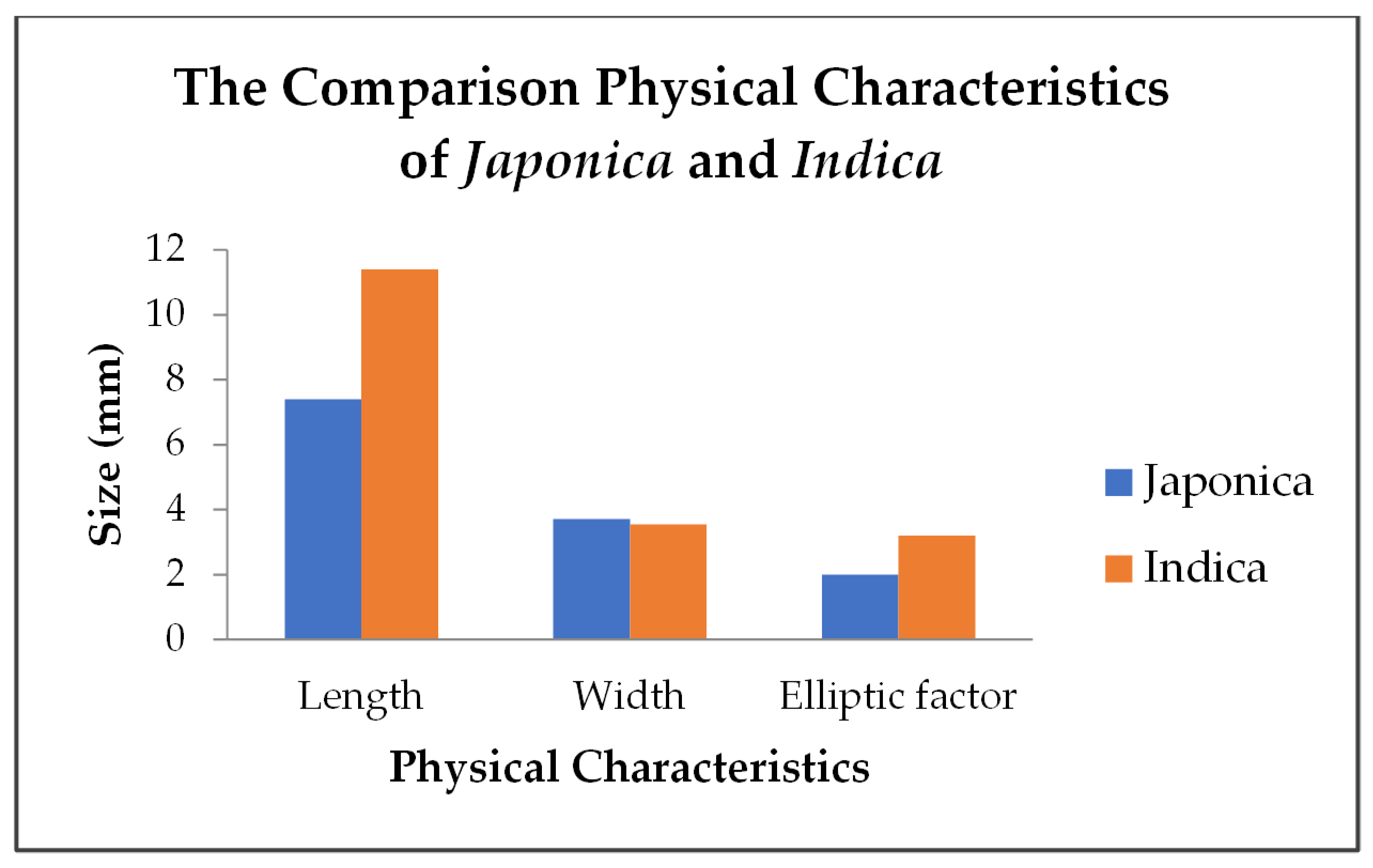

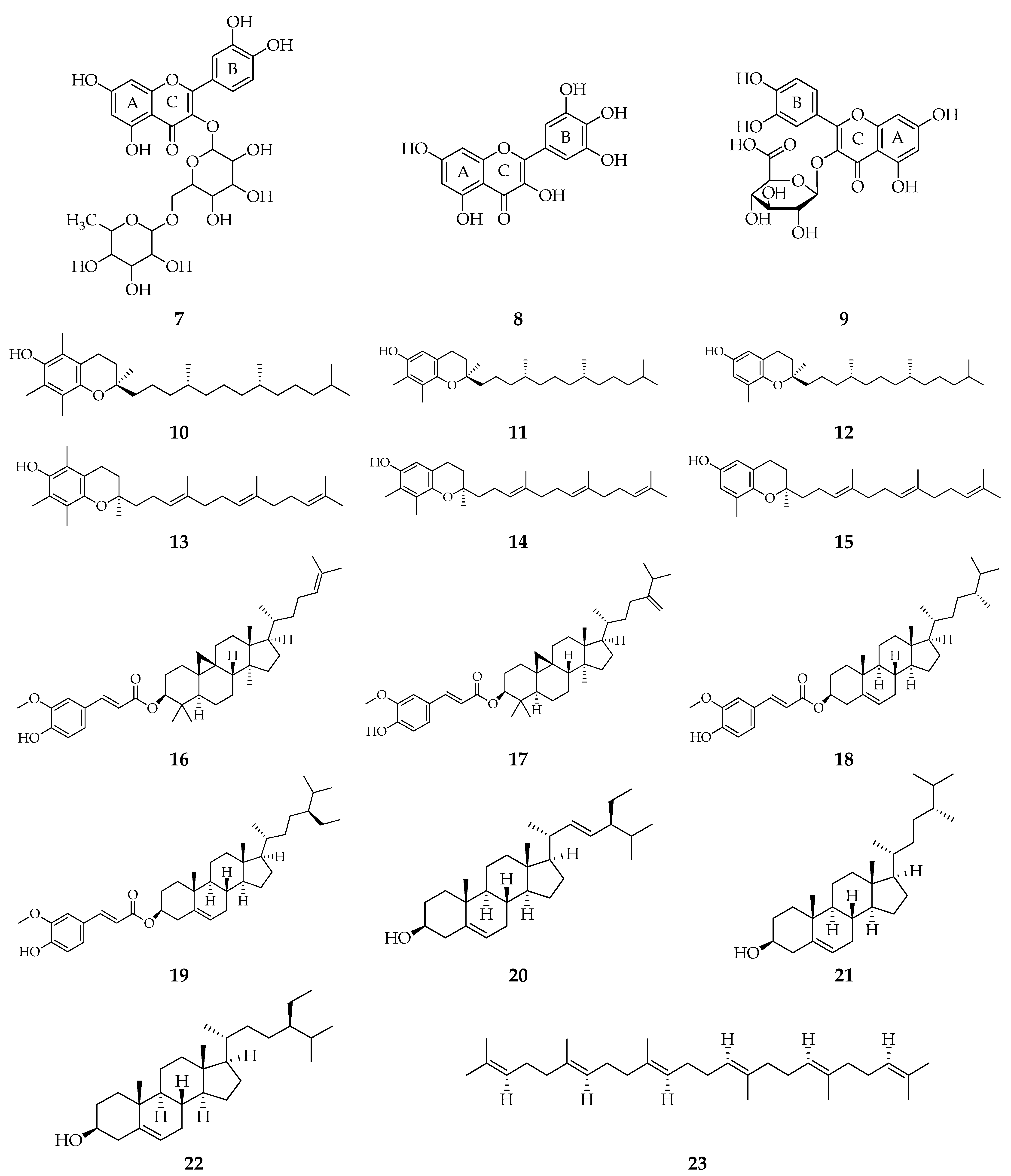
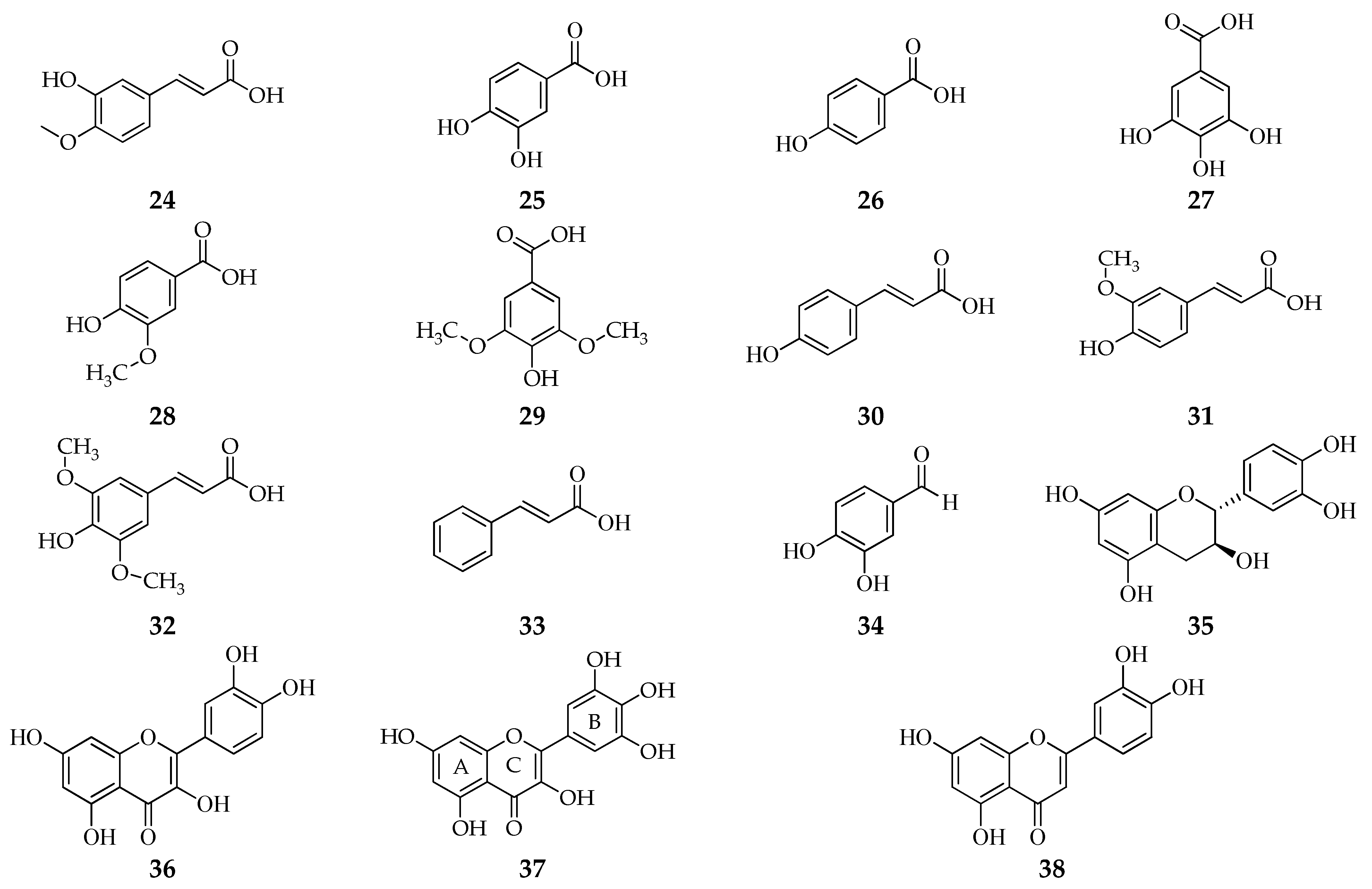
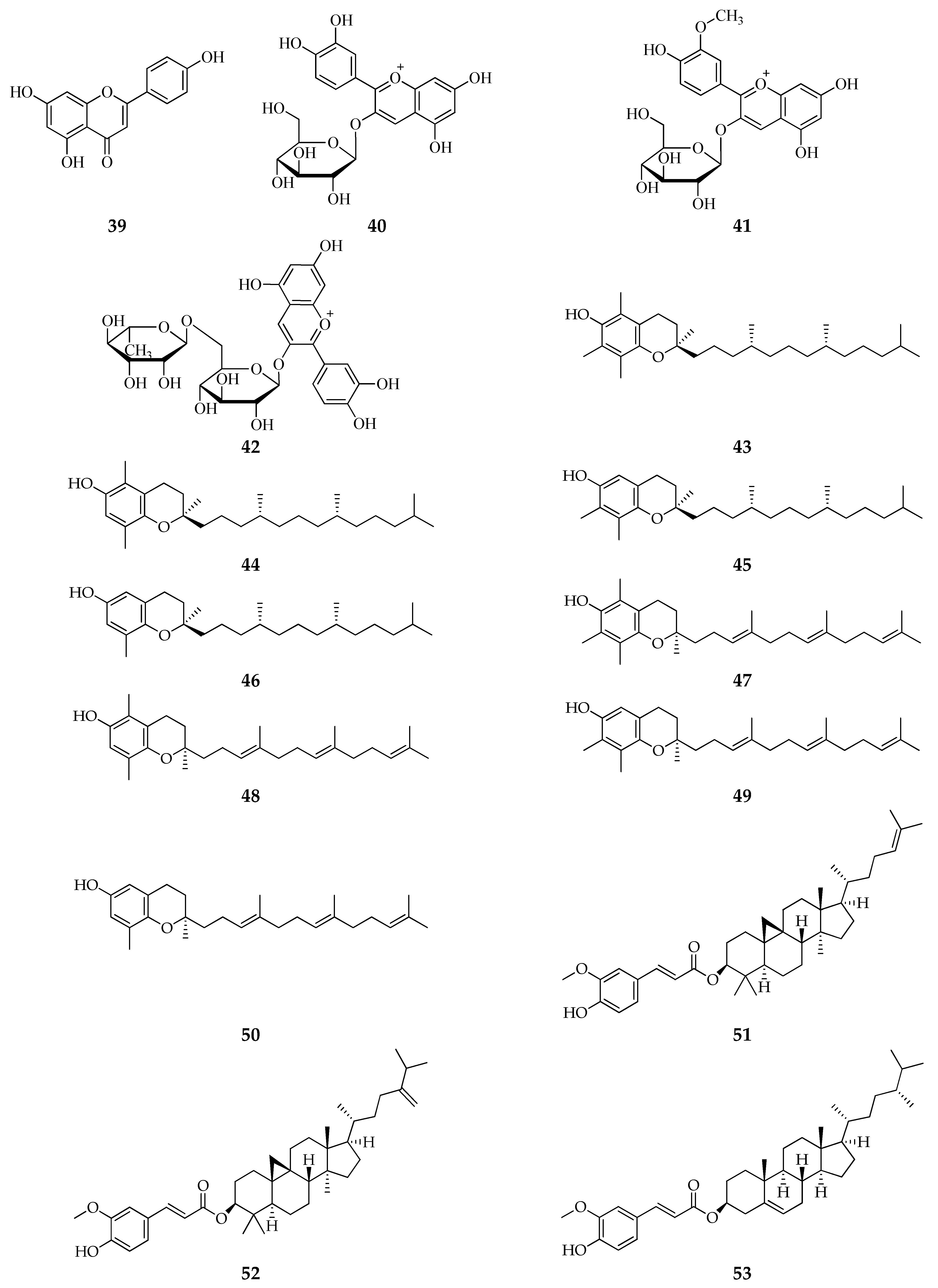

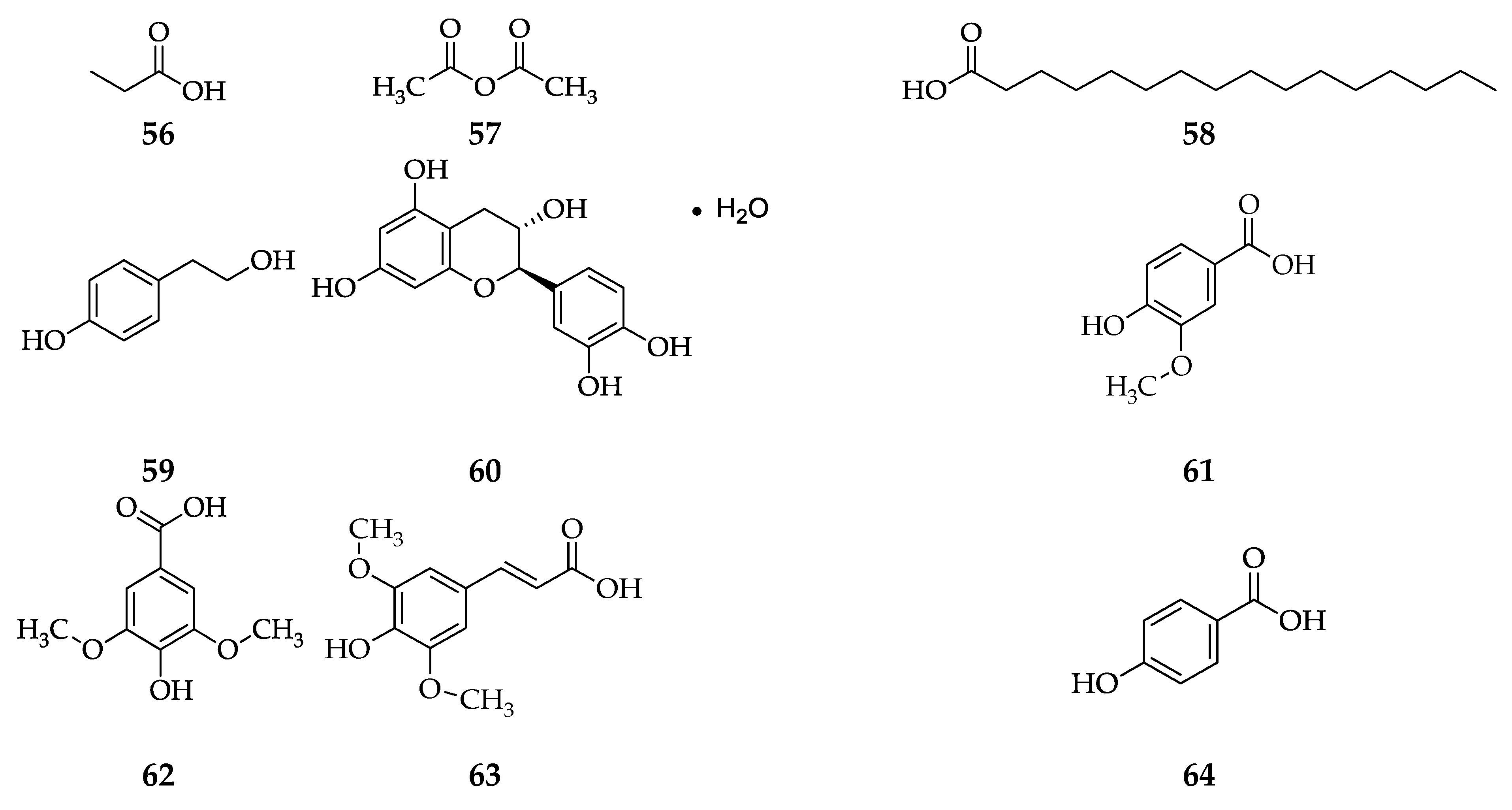
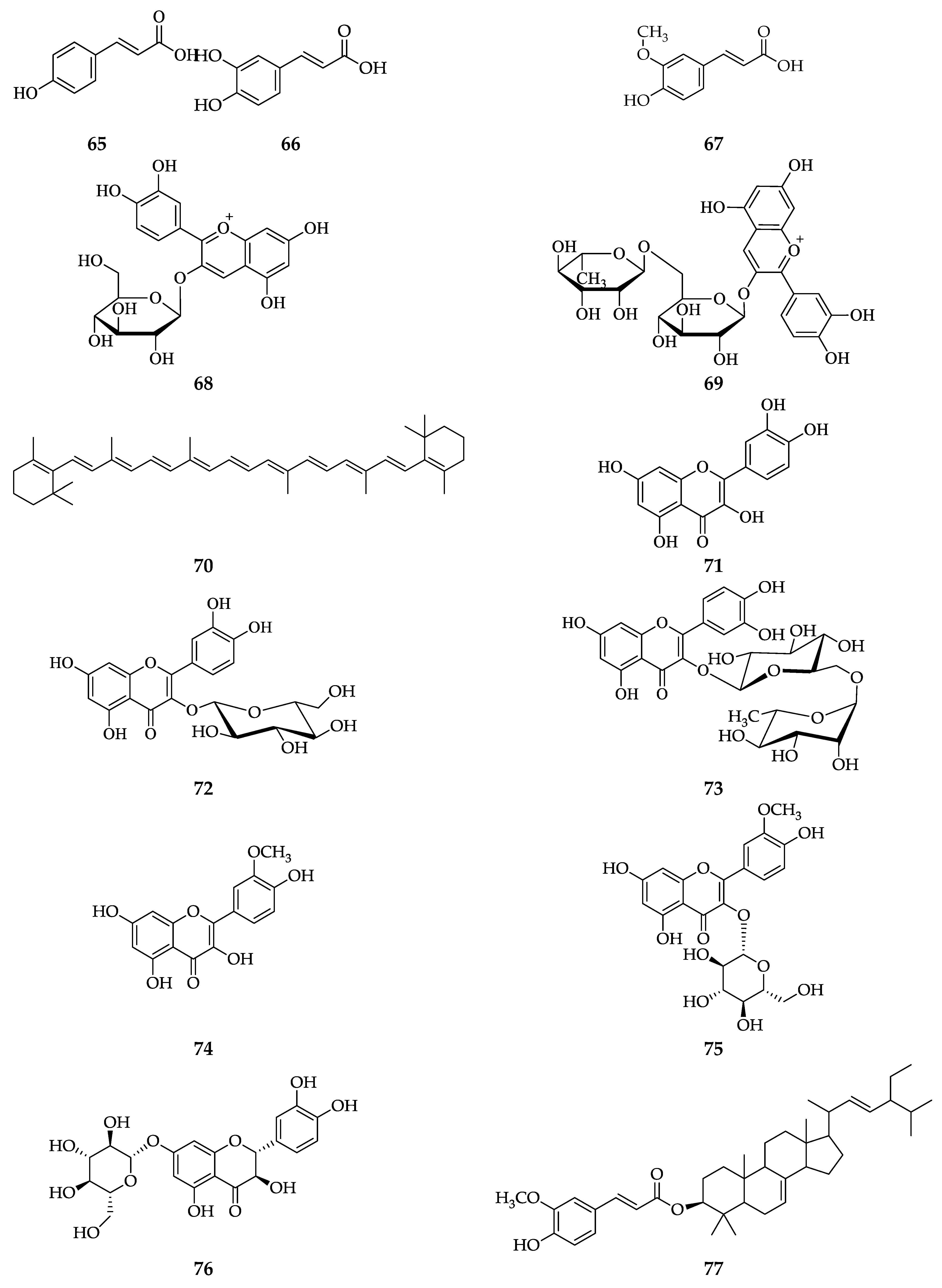
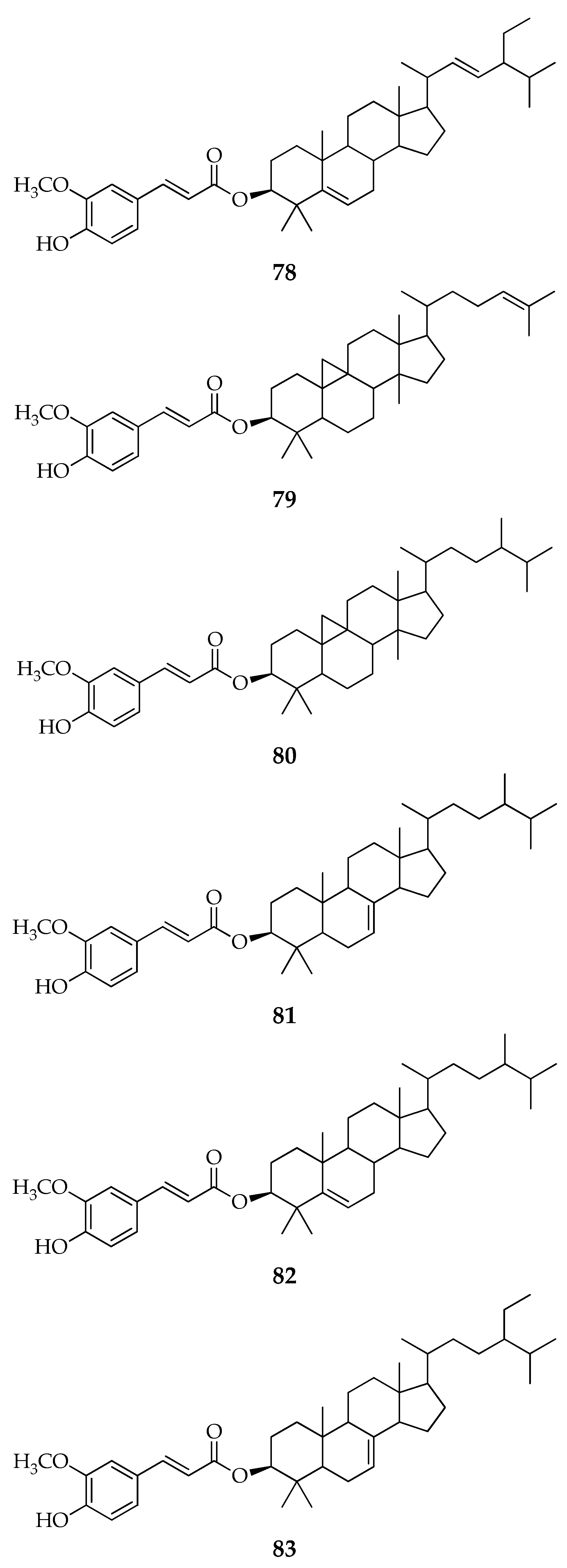
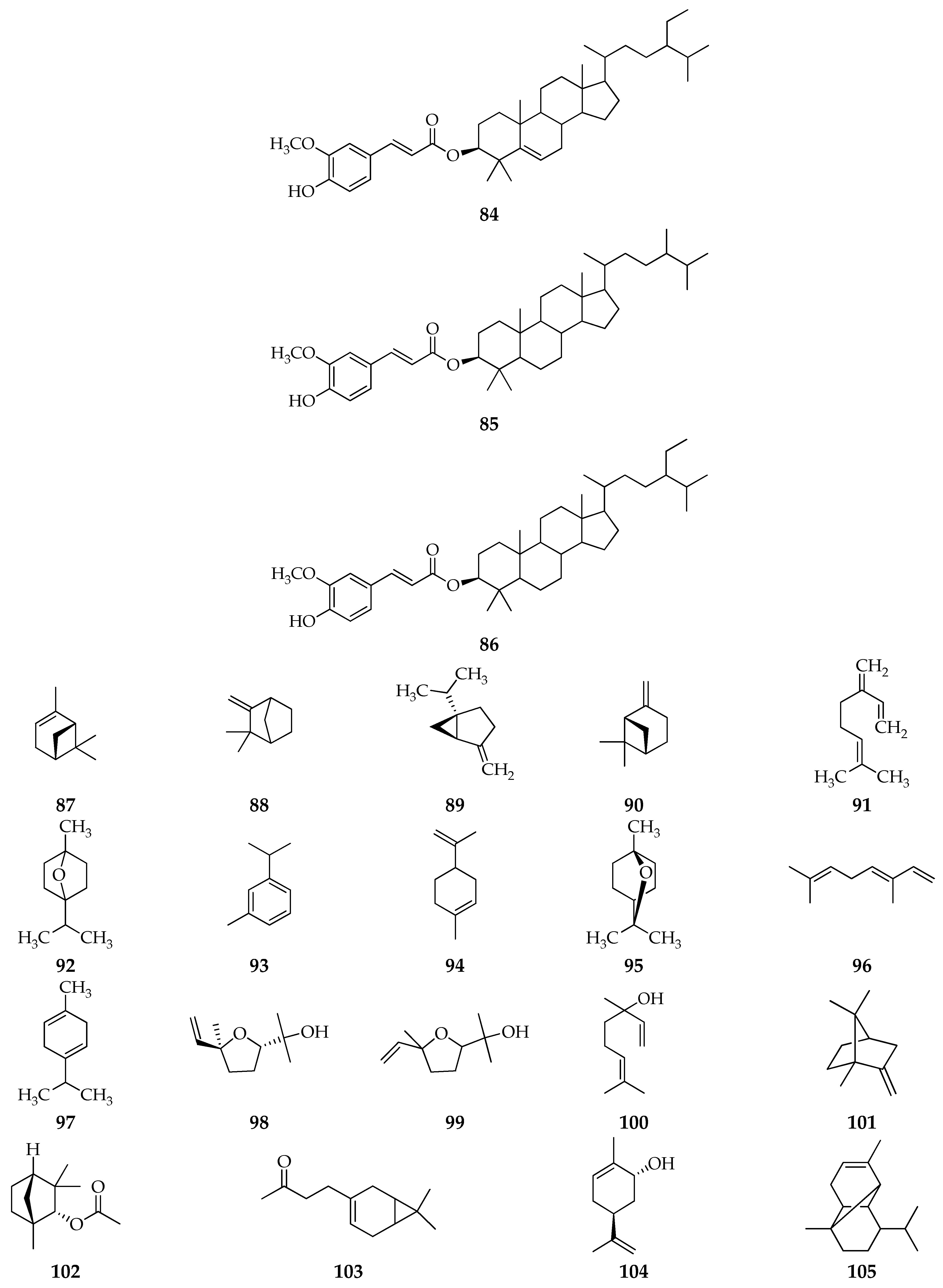

| Variety (Source) | Method | Effect | Reference |
|---|---|---|---|
| Japonica type variety unknown (Seoul, Korea) | treated with different carbohydrases (Viscozyme, Termamyl, Celluclast, AMG, Ultraflo, and Pentopan) | ethanol extract (%), reducing sugar (mg/g), and total phenolic content (mg GAE/g) increased | [118] |
| Jyothi variety red rice paddy (Karnataka, India) | treated with Bacillus Endoxylanase (EXB) and Trichoderma Endoxylanase (EXF) | total flavonoid; individual soluble phenolic components cycloartenyl ferulate; β-sitosteryl ferulate; and δ, γ, α-tocotrienols and tocopherols increased | [48] |
| Unknown (Yogyakarta, Indonesia) | fermented with Lactobacillus plantarum and Lactobacillus lactic | total phenolic content (mg GAE/g dw) increased | [119] |
| Khao Bahn Nah and Thai jasmine (Prachin Buri province, Thailand) | fermented with Lactobacillus casei and Lactobacillus plantarum | polysaccharide (mg/mL) decreased and total phenolic content (mg/mL) increased | [120] |
| BR-IRGA 417 (Brazil) | fermented with Rizhopus oryzae | total phenolic content (mg/g) increased | [121] |
| Unknown (Stuttgart, Ark., U.S.A.) | fermented with Bacillus subtilis subspecies subtilis NRRL NRS-744 | total phenolic content (mg FAE/g) increased | [122] |
| PB-1121 (Sirsa, India) | solid-state fermentation (SSF) with Aspergillus oryzae MTCC 3107 | total phenolic content (g GAE/g dwb) and condensed tannin content (mg CE/g dwb) increased | [123] |
| IR 64 and Jyothi (Karnataka, India) | treated with Cellulase from Aspergillus niger (1.4 U/mg solid) from Sigma-Aldrich, USA and Xylanase D-762-p (400 U/g solid) from Biocatalyst | γ-oryzanol; soluble, bound, and total polyphenols; flavonoid and tannin content increased | [124] |
| RD6 (Chiang Mai Rice Research Center, Thailand) | Three different methods were used for comparison, namely enzymatically stabilized rice bran (ESRB) using (trypsin, chymotrypsin, papain, bromelain, or Flavorzyme) enzymes; raw rice bran (RRB) without any treatment; and thermally stabilized rice bran (TSRB) which is raw rice bran heated at 100 °C in open steam for 15 min | free phenolics, γ-oryzanol, tocopherols, and tocotrienols content in ESRB is higher compared with TSRB and RRB | [125] |
| Jyothi paddy (Karnataka, India) | Rice bran was treated with a combination of endo-1,4-beta-xylanase (EXYL) and Fiberzyme (Fzyme) enzymes. Three combinations of the two enzymes were performed, namely 1.5 BGU + 3 EXU (CXC1), 3 BGU + 2 EXU (CXC2), and 4.5 BGU + 1 EXU (CXC3) enzymes. | The content of ferulic acid in soluble phenolics, p-coumaric acid in bound phenolics, and γ-oryzanol fractions increased the most in the combination CXC2. In addition, ferric reducing power, DPPH• scavenging capacity, nitric oxide scavenging, and inhibition of human LDL oxidation were increased for all three types of enzyme combination. Superoxide anion and hydroxyl radical scavenging activities increased for the combination of CXC1 and CXC2 enzymes. | [126] |
| Khao Dok Mali 105 (Suphan Buri Province, Thailand) | Six different pretreatment methods were carried out in rice bran to extract rice bran oil, such as microwave heating (60–110 °C for 3 min), hot air heating (70–180 °C for 10 min), roasting (60 and 80 °C for 3 min), parboiling (75 °C for 60 min), autoclave heating (121 °C for 15 min), and hydrolysis with α-amylase 1375 units/mL under the optimum condition for enzyme activity (180 rpm, at 50 °C for 120 min) | Pretreatment with roasting at 60 °C produced the highest γ-oryzanol content which was 46.9 mg/mL of rice bran oil. | [127] |
| Unknown (Kuala Lumpur, Malaysia) | fermented with Rhizopus oligosporus (strain F0020) and Monascus purpureus (strain F0061) | The phenolic acid content in methanol extracts of fermented rice bran such as ferulic, sinapic, vanillic, caffeic, syringic, and 4-hydroxybenzoic acids increased | [128] |
| KDML 105 (Northeastern Thailand) | Three different types of pretreatment were carried out on rice bran compared with raw bran, namely hot-air (120°C for 30 min), far-infrared radiation (FIR), and hydrolysis with cellulase | There was an increase in DPPH radical scavenging activities, ferric reducing antioxidant power (FRAP), total phenolic content (TPC), several phenolic acids, α-tocopherols, γ-tocopherols, and δ-tocopherols; the highest was in rice bran treated with FIR-treated | [129] |
| Axios-Long A type (Unknown) | infrared radiation heating | There was an increase in phenolic content and antioxidant activity in the bound extract of rice bran which was directly proportional to the increase in IR power. | [130] |
| Unknown (Rio Grande do Sul, Brazil) | fermented rice bran by Saccharomyces cerevisiae for gluten-free cookies formulation with different fermented rice bran composition, namely 7.08%, 14.16%, and 28.33% | Cookie formulations with a fermented rice bran composition of 7.08% showed the highest phenolic compound content compared with the others and was higher than cookies without fermented rice bran. | [131] |
Publisher’s Note: MDPI stays neutral with regard to jurisdictional claims in published maps and institutional affiliations. |
© 2022 by the authors. Licensee MDPI, Basel, Switzerland. This article is an open access article distributed under the terms and conditions of the Creative Commons Attribution (CC BY) license (https://creativecommons.org/licenses/by/4.0/).
Share and Cite
Andriani, R.; Subroto, T.; Ishmayana, S.; Kurnia, D. Enhancement Methods of Antioxidant Capacity in Rice Bran: A Review. Foods 2022, 11, 2994. https://doi.org/10.3390/foods11192994
Andriani R, Subroto T, Ishmayana S, Kurnia D. Enhancement Methods of Antioxidant Capacity in Rice Bran: A Review. Foods. 2022; 11(19):2994. https://doi.org/10.3390/foods11192994
Chicago/Turabian StyleAndriani, Riza, Toto Subroto, Safri Ishmayana, and Dikdik Kurnia. 2022. "Enhancement Methods of Antioxidant Capacity in Rice Bran: A Review" Foods 11, no. 19: 2994. https://doi.org/10.3390/foods11192994
APA StyleAndriani, R., Subroto, T., Ishmayana, S., & Kurnia, D. (2022). Enhancement Methods of Antioxidant Capacity in Rice Bran: A Review. Foods, 11(19), 2994. https://doi.org/10.3390/foods11192994






